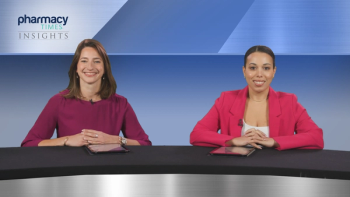
Optimizing Multiple Myeloma Treatment With Anti-CD38 Agents
Medical experts emphasize anti-CD38 agent utilization for treatment of patients with multiple myeloma.
Episodes in this series

Ryan Haumschild, PharmD, MS, MBA: Dr Maples, how are anti-CD38 agents being used? If you could, separate it for the standard-risk patient type and the high-risk patient for us.
Kathryn Tyler Maples, PharmD, BCOP: Absolutely, I would completely agree. Anti-CD38 monoclonal antibodies are becoming the backbone of myeloma therapy in all 3 of our buckets. We have the frontline setting, the maintenance setting, and then also the relapsed/refractory setting. You can see anti-CD38 agents in all 3 of those. First, separating those standard-risk patients, we saw daratumumab specifically start to be incorporated in the frontline setting. Most notably we have the MAIA trial, the GRIFFIN trial, and the CASSIOPEIA trial, which all started to use daratumumab up front. In all 3 of those studies, the majority of the patients included were standard risk. About 85% in all of those studies were standard-risk patients, so we can feel confident about extrapolating those results to our standard-risk patients. We saw across the board that adding daratumumab increased depth of response. We do know, as we’ve mentioned previously, that depth of response often correlates to duration of response as well. Adding daratumumab up front I think has been accepted in many cases for our standard-risk patients.
The data haven’t quite been there for high risk, it’s a little more controversial. I think that people will have different interpretations of the data there since fewer people were included. However, we are starting to see newer trials focus only on high-risk patients. We have the MASTER trial, we have the GMMG-Concept trial with isatuximab, both looking at combining an anti-CD38 agent with KRd [carfilzomib, lenalidomide, dexamethasone] in our high-risk newly diagnosed patients. I think more is going to come and help answer the question of what the role is in anti-CD38s for newly diagnosed high-risk patients. In my experience, using an anti-CD38 in those standard-risk patients has become very common.
I think in terms of maintenance and relapsed/refractory, that’s another question. In the maintenance setting, I’m not sure about the utilization of an anti-CD38 agent. You don’t have me fully convinced yet. In the CASSIOPEIA trial, we didn’t see that continuing daratumumab in the maintenance setting made a significant difference. While you could use it up front to help achieve a deeper response, you may not always continue it in the maintenance setting. Then that leads us into the relapsed/refractory setting. Even if a patient had an anti-CD38 up front, if they were not continued on it in their maintenance setting, you could still use it again once they relapsed because they wouldn’t be refractory to that agent. That’s where I see it most commonly, we are still using a lot of anti-CD38 backbone regimens in that first relapse setting. That could be daratumumab or isatuximab, typically with a combination of pomalidomide and dexamethasone, or carfilzomib and dexamethasone. I think we’re seeing it used across the board in both standard-risk and high-risk patients. We have a bit more data right now in standard risk, but more are coming every day.
Ryan Haumschild, PharmD, MS, MBA: You’re right, I feel like there is a trial coming out every day. I know especially at the ASH [American Society of Hematology] annual meeting, we’re going to learn a lot more of what’s coming here. As we pivot to Dr Ali, we know that for many patients with multiple myeloma, triplet regimens have evolved as the standard of care of treatment. In your opinion, what has driven the change toward these 3-drug regimens that we now all mainly utilize, and what is the benefit of utilizing combination therapy? Also, maybe talk to our viewers a bit about the importance of leveraging the multiple mechanisms of action within the treatment?
Amir Ali, PharmD, BCOP: Over the years, we’ve made this significant move from single agents to doublets to triplets, now quadruplets. That’s a result of the overwhelming evidence we’ve seen from these phase 3 clinical trials in general, that the triplets are doing better than the doublets. What’s helping increase this utilization is the development of these drugs that have fewer adverse effects and are easier to administer. Those oral routes or subcutaneous routes, and it’s really easy to just tack on another therapy to a doublet. Whenever you add something, that always increases your risk of toxicity, so typically triplets are more intensive than doublets, and they’re associated with an increased risk of adverse effects.
You mentioned the question about leveraging multiple mechanisms. I think that’s critically important in the treatment of multiple myeloma. We see this both biologically and clinically as well. The disease itself has different manifestations, and they call it multiple myeloma for a reason, I tell my students this. It’s a very heterogeneous disease, so hitting it with multiple mechanisms is key for the treatment here. The combination data we see reinforce this.
Ryan Haumschild, PharmD, MS, MBA: I think you brought up some great points about the benefits. I’m curious about Dr Hossain’s standpoint. What’s been your experience with these anti–CD38-containing triplet regimens in the relapsed/refractory patient population?
Shahrier Hossain, PharmD, BCOP: In my experience, these are very well-tolerated medications. It’s far more often that I have to adjust someone’s pomalidomide or carfilzomib doses as opposed to giving them a break from isatuximab or daratumumab. Patients are able to tolerate these infusions and injections fairly well. I will say that my use of daratumumab has been dominant but may change with the recent trials. With the subcutaneous formulation, it becomes a 5-minute injection as mentioned earlier. There have also been a lot of pharmacists-led projects out there from BMC [Boston Medical Center] and the Mayo Clinic and even our own internal projects at Dana-Farber Cancer Institute that have suggested that the monitoring period be shortened or omitted entirely. I think at our practice we now only do 2 hours for that first dose, and then patients are free to go wherever they need to go.
There are also studies about premedications now from Cedars-Sinai Medical Center that looked at omitting premedications from daratumumab altogether. That was a great study that we’ve implemented at our own practice. Now, premedications are gone after cycle 3 of daratumumab. I think isatuximab still has issues with infusion reactions right now, but as we get more experience in using this medication as we do more projects, this will also go in that direction of, how we can make this easier for our patients. How can we make this a faster appointment for our patients, and what can we get rid of that they no longer need?
Transcript edited for clarity.
Newsletter
Stay informed on drug updates, treatment guidelines, and pharmacy practice trends—subscribe to Pharmacy Times for weekly clinical insights.



